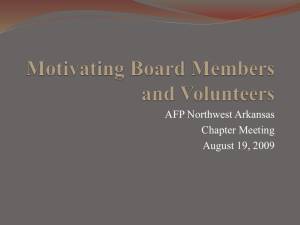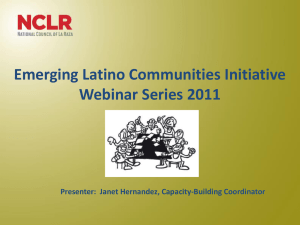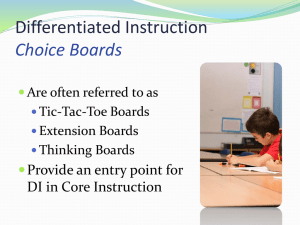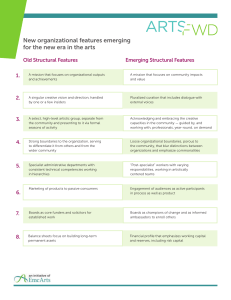Boards and Committees
advertisement
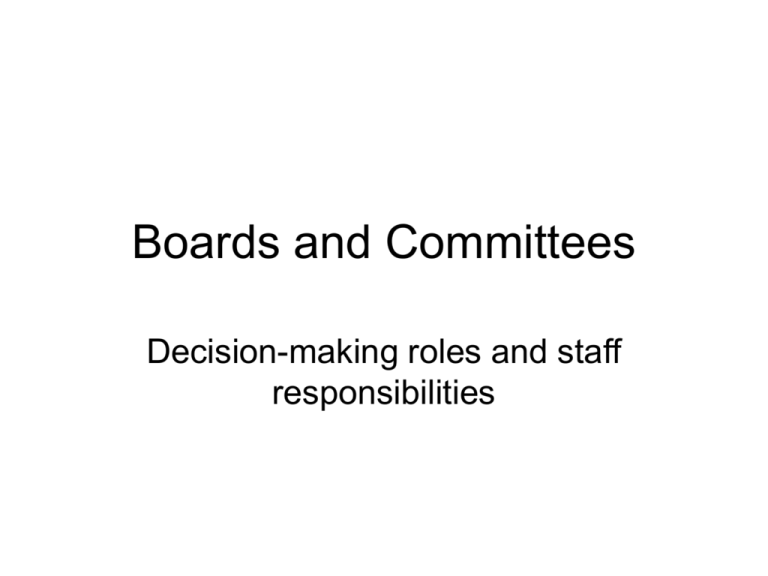
Boards and Committees Decision-making roles and staff responsibilities . Boards are the primary decision-making structure in nonprofit organizations. • • • • • • Corporations and some government agencies also have boards, although responsibilities and roles may differ. In most nonprofit organizations, board members are volunteers. Board members set policies for the organization. On some boards, members may be expected to fundraise, lobby on behalf of the organization with government, help obtain publicity for the organization, or volunteer to help run programs or deliver services. Organizations generally look for board members that are influential in the community, have connections to other powerful people, or that can raise money. In some cases, organizations look for board members that have special skills that can be used to help the organization (for example, lawyers, accountants, social workers etc.). Clients or community residents may be seated on boards if they are believed to be knowledgeable about client needs or if they can provide a link between the organization and the community. Boards are responsible for the fiscal oversight of the organization and are legally liable if funds are misspent. Boards hire and fire the executive director. Holland (1998) identifies six competency areas for board members: • • • • • • Contextual. The board understands the norms and values that influence the organization’s culture and uses this understanding to guide its actions. Educational. The board makes sure that all members are informed about organization operations and their own roles in decision-making. Interpersonal. The board members engage in activities that help them develop a sense of group cohesion. Analytical. Board members adequately gain an understanding of the issues they address and take into account a variety of perspectives on these issues. Political. The board develops and maintains good relationships with constituency groups within and outside the organization. Strategic. The board is actively involved in making decisions that pertain to the organization’s future direction. Why would anyone want to be on a board? • Altruism • Give service to community • Likely to use the service or be a parent or relative of someone who uses the service • Employer may require participation in community service. • Opportunity for networking or finding employment opportunities. • Social opportunities • Provides visibility in the community (promote yourself or your business) Boards have: • Officers (usually President, Vice-President, Secretary, and Treasurer). • Rules for making decisions (By-laws). • A set of formal procedures (Roberts Rules of Order) in most organizations. • Established meeting times • A predetermined number of members There are different views about the board’s relationship with the executive director: • Partnership between the board and the director. • The director does most of the work because he or she has expertise. The board simply makes policy based on what the director tells them. • The executive director follows the orders of the board. Executive Directors should have the following skills: • • • • • • • • Choosing information to be presented to the board. Selecting items to be placed on the agenda. Building working partnerships with board members. Using effective verbal and written communication of recommendations for policies and procedures. The ability to work with a variety of people The ability to communicate the experiences and perspectives of clients and staff to the board and to advocate, as appropriate for these constituency groups. The ability to communicate with board members about strategies that should be used for interactions with people and institutions in the organization’s external environment The ability to work with the board and other key constituency groups to develop operational and strategic (long-term) plans for the organization (Hardina & Malott, 1996a; Holland, 1998; Murray et al., 1992; Tropman, 1997). Roberts Rules are used by many boards to guide decision-making • Based on a formal, hierarchical structure. • Requires that proposals for decisions be made in terms of motions – motion must be seconded, a period of discussion is allowed, and then there is a vote. Motions and votes are recorded in the board minutes • Involves majority rule. • Chair (usually the Board President is in charge) • Strict use of Robert’s Rules can tie up decisionmaking. Not everyone uses or likes the Robert’s Rules model • Some people are more comfortable with consensus. • A modified form of Robert’s Rules can be used that includes consensus building. Board members may be: • Appointed • Nominated by a Committee of the Board • Elected One primary assumption of much of the recent literature on boards is that boards should be diverse in terms of gender, ethnicity, and social class. Inclusion of people with diverse interests in organization decisionmaking is believed to improve the quality of services, stimulate innovation, and help the organization balance the demands of funders with the needs of the community (Parker & Betz, 1996). The term “diversity” as it pertains to organization board generally refers to member skills and experience as well as demographic characteristics such as age, gender, ethnicity, physical or mental disabilities, sexual orientation, and social class (Daley, 2002). Parker and Betz (1996) identify a number of effective methods for recruiting members of diverse groups for membership on boards: • Ask community leaders to identify prospective board members. • Extend face-to-face invitations to potential recruits. • Use established community groups as recruiting pools for participants. • Identify and recruit informal community leaders. • Hold board or planning meetings at times when prospective members can easily attend them. • Plan special events or activities that can be used to introduce the organization to new people. • Provide training for new board members so that they understand they role and duties. Boards delegate some of their work to committees: • Committees are smaller groups that have a specific task or function. • May be regular (standing) committees or ad hoc (temporary). • May include people who are not on the board. • May be internal to the organization and be made up of staff members or a mixture of clients, staff, board members or people outside the organization. One type of committee is a task force: • Consists of staff members or other representatives of organizations that serve the same community or target population. • A Task Force can also include community leaders and representatives of constituency groups. • They are intended to be time limited and are established to address unmet needs or urgent problems. • One advantage of this type of decision-making vehicle is that permits an organization to engage in problem-solving on one new issue without losing its ability to focus on its primary goals (Often task forces start out as informal groups and transition into formal coalitions or collaborative, partnerships in which organizations establish formal decision-making structures to lobby government for funds or legislation or engage in the joint delivery of services). Most committees or task groups elect a chairperson, although administrators may appoint internal committee chairs. • • • • Committee leaders are responsible for chairing meetings, helping the group to set goals and decision-making rules, resolving conflicts among members, and identifying tasks to be completed by the group. In most cases, the chair will set the agenda and schedule meetings, although some of these responsibilities may be delegated to staff members. The chair is also the person responsible for making sure that the agenda is followed during meetings and following up with group members to make sure their assignments have been completed. The chair must make sure that committee members feel involved and committed. Committee members may not contribute to the group unless they feel involved in decision-making and that they have made a contribution to the group’s success. Many committees in social service organizations also receive support from a designated staff person. Staff responsibilities can include: • Establishing a good working relationship with the chair. • Helping the chair set the agenda. • Providing information about what decisions should be made and when. • Preparing written agendas and meeting minutes. • Researching issues to be addressed by the committee. • Sending out meeting reminder notices to members. • Providing technical expertise. • Preparing reports and other written products in consultation with community members Power Given what we’ve said about organizational hierarchies, who do you think has the most power in nonprofit organizations: Board members or the executive director? If we are recruiting upper, middle, and low-income or members of other marginalized groups to the board, which of the board members can be expected to have the most power? Techniques that can be used by Executive Directors to Limit Board Power (What not to do) • Help select board members • Encourage board members to recruit friends, employees, and relatives for seats on the board • Encourage board members to stay on the board rather than rotate off when their terms expire; do not support efforts to diversify the board • Manipulate the selection of the board president and other officers so that people who like you are select • Develop all policy recommendations for the board – limit discussion to up or down votes. • Withhold financial and other documentation from the board • Provide limited training to board members. Use training material that encourages board members to limit their role to approving policies or reviewing prepared financial statements. • Establish an advisory committee with no power, authority, decisionmaking role that meets infrequently Techniques that can be used by the executive director to build a diverse and empowered board • Encourage the board’s nominating committee to recruit a diverse board (in terms of gender, age, social class, ethnicity, sexual orientation, disability status) • Establish a working partnership with the board • Provide leadership and guidance that transmits values that promote respect, empowerment ,and cooperative relationships among board members. • Provides supports (training, board self-evaluation procedures, transportation, translation services, conflict resolution, mentorship for new board members, an appropriate committee and decision-making structure) that allows for the maintenance of a healthy board. • Establishes an advisory committee with diverse members with a definite purpose and responsibilities Consumer Control • Highest level of participation • Most organizations range from low to high on the scale. • Consumers/service users are most effective on boards when they represent a constituency group and have access to other sources of power such as information, education and training to enhance technical decision-making, and the media.
